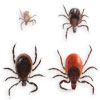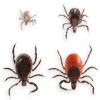KINGSTON, R.I. – July 30, 2007 — The number of nymphal deer ticks is down so far this year in most of Rhode Island, but numbers have taken an alarming jump in parts of Newport County, according to sampling studies conducted last month.
Deer ticks transmit the agents causing Lyme disease, babesiosis and anaplasmosis.
Congressman Patrick Kennedy joined today with Thomas N. Mather, director of the Center for Vector-Borne Disease at the University of Rhode Island, to discuss the increases in the number of ticks in some areas of Newport County, ranging from 50 to 850 percent above last year’s counts.
“The upswing in tick numbers in the Newport area is significant and something we should all be aware of, particularly since counts in most other areas of the state are lower,” Kennedy said. “Much more needs to be done to educate East Bay residents about the risks posed by ticks and the simple strategies we all can employ to protect ourselves from being bitten.”
Kennedy and Sen. Jack Reed have successfully secured $440,000 over the past five years to support tick-bite prevention research and outreach in Rhode Island.
 Mather noted that tick counts traditionally have been low in Newport County when compared to other parts of Rhode Island. As a result, many residents there have found some comfort in the belief that if the tick counts are low, the risk of tick-transmitted diseases such as Lyme disease was low, too.
Mather noted that tick counts traditionally have been low in Newport County when compared to other parts of Rhode Island. As a result, many residents there have found some comfort in the belief that if the tick counts are low, the risk of tick-transmitted diseases such as Lyme disease was low, too.
But not this year. Sampling done in a wooded area adjacent to Beavertail State Park in Jamestown shows that the tick count there jumped 842 percent over last year. At a creek on North Road in Jamestown, there was a 50 percent increase in the number of ticks.
In Little Compton, the tick count increased by 100 percent in the William Sisson Road area and 220 percent in the South Lake Road area. At the Norman Bird Sanctuary in Middletown, the tick count was 272 percent higher than in 2006. The sanctuary is a destination for many bird lovers and day campers, and is the venue for numerous public events.
In contrast, Mather reported that on average, tick abundance is running 22.5 percent lower statewide when compared with the same period one year ago. One factor for the overall lower counts this summer may be the relatively high number of low humidity days and long periods of days without rain. In 2006, tick abundance counts statewide were the second highest recorded in the 15 years that tick abundance has been monitored, and 2006 was one of the wettest summers in recent history.
In making the tick counts, Mather’s team of researchers use standardized protocols that include dragging white flannel cloths over the ground in wooded sites. The tiny ticks latch onto the cloth in the hopes of finding a warm, blood meal, and are counted every 30 seconds for a total of 45 minutes at each location. “We collect thousands of ticks each year,” Mather explained, “and this surveillance effort has provided us with very reliable data regarding changes in tick encounter risk.”
The URI Center for Vector-Borne Disease is seeking state and additional federal support to increase tick-bite prevention awareness and tick control programs throughout Rhode Island. Its website, www.tickencounter.org, provides users with information on effective strategies for protecting themselves, their yards, and their pets.

